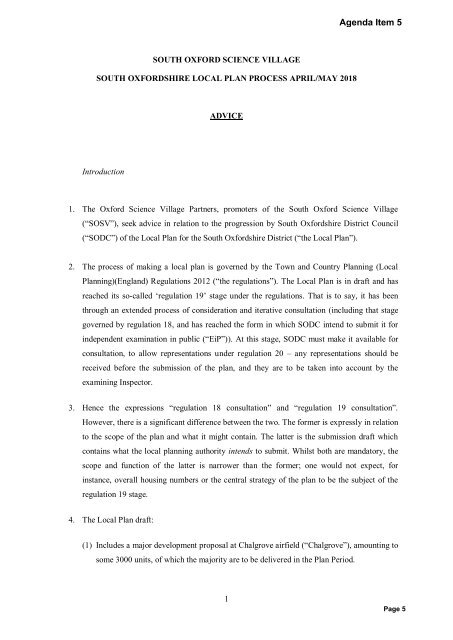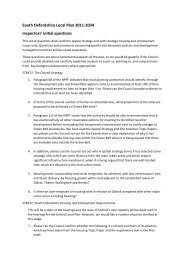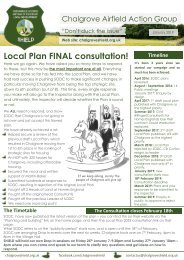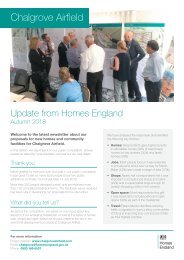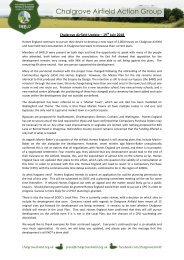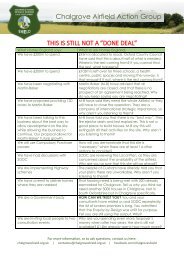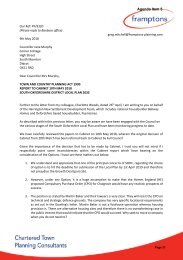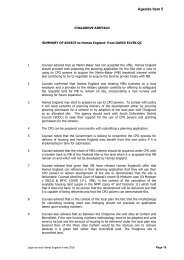Legal advice to Oxford Science Village Partners 2 May 2018
Create successful ePaper yourself
Turn your PDF publications into a flip-book with our unique Google optimized e-Paper software.
Agenda Item 5<br />
SOUTH OXFORD SCIENCE VILLAGE<br />
SOUTH OXFORDSHIRE LOCAL PLAN PROCESS APRIL/MAY <strong>2018</strong><br />
ADVICE<br />
Introduction<br />
1. The <strong>Oxford</strong> <strong>Science</strong> <strong>Village</strong> <strong>Partners</strong>, promoters of the South <strong>Oxford</strong> <strong>Science</strong> <strong>Village</strong><br />
(“SOSV”), seek <strong>advice</strong> in relation <strong>to</strong> the progression by South <strong>Oxford</strong>shire District Council<br />
(“SODC”) of the Local Plan for the South <strong>Oxford</strong>shire District (“the Local Plan”).<br />
2. The process of making a local plan is governed by the Town and Country Planning (Local<br />
Planning)(England) Regulations 2012 (“the regulations”). The Local Plan is in draft and has<br />
reached its so-called ‘regulation 19’ stage under the regulations. That is <strong>to</strong> say, it has been<br />
through an extended process of consideration and iterative consultation (including that stage<br />
governed by regulation 18, and has reached the form in which SODC intend <strong>to</strong> submit it for<br />
independent examination in public (“EiP”)). At this stage, SODC must make it available for<br />
consultation, <strong>to</strong> allow representations under regulation 20 – any representations should be<br />
received before the submission of the plan, and they are <strong>to</strong> be taken in<strong>to</strong> account by the<br />
examining Inspec<strong>to</strong>r.<br />
3. Hence the expressions “regulation 18 consultation” and “regulation 19 consultation”.<br />
However, there is a significant difference between the two. The former is expressly in relation<br />
<strong>to</strong> the scope of the plan and what it might contain. The latter is the submission draft which<br />
contains what the local planning authority intends <strong>to</strong> submit. Whilst both are manda<strong>to</strong>ry, the<br />
scope and function of the latter is narrower than the former; one would not expect, for<br />
instance, overall housing numbers or the central strategy of the plan <strong>to</strong> be the subject of the<br />
regulation 19 stage.<br />
4. The Local Plan draft:<br />
(1) Includes a major development proposal at Chalgrove airfield (“Chalgrove”), amounting <strong>to</strong><br />
some 3000 units, of which the majority are <strong>to</strong> be delivered in the Plan Period.<br />
1<br />
Page 5
Agenda Item 5<br />
(2) Does not allocate SOSV, but does seek <strong>to</strong> allocate strategic allocations at Berinsfield and<br />
Culham, both of which currently lie in the Green Belt.<br />
5. On 27 March <strong>2018</strong>, the Full Council of SODC resolved <strong>to</strong> reconsider the draft Local Plan,<br />
specifically by reference <strong>to</strong> two ‘options’:<br />
(1) Remove Chalgrove and replace it with another site or sites (referred <strong>to</strong> as “Option 2”); or<br />
(2) Retain Chalgrove and supplement it with one or more “reserve sites” (“Option 3”).<br />
6. In so doing, the Full Council rejected the suggestion made by the then Leader of SODC that<br />
there be no change <strong>to</strong> the substance of the Local Plan (“Option 1”).<br />
7. What led <strong>to</strong> the 27 March <strong>2018</strong> resolution was an accumulation of evidence that the<br />
Chalgrove site may not be deliverable in the timescale envisaged by SODC when producing<br />
the draft plan. This is principally due <strong>to</strong> the possibility that Homes England (the Government<br />
Agency which intends <strong>to</strong> deliver the Chalgrove scheme) may not be able secure the<br />
ownership of the Chalgrove site without using powers of compulsory acquisition; and funding<br />
problems with necessary road infrastructure <strong>to</strong> serve the strategic scheme at Chalgrove.<br />
8. In resolving <strong>to</strong> proceed on the basis of either Option 2 or Option 3, SODC Council has, in<br />
effect, decided that the Local Plan cannot be submitted <strong>to</strong> the Secretary of State for EiP<br />
without removing, replacing or supplementing Chalgrove, as <strong>to</strong> rely on it as a strategic<br />
allocation would be likely <strong>to</strong> be found unsound and require a main modification. In<br />
considering the matter, SODC apparently received legal <strong>advice</strong> from leading counsel<br />
suggesting that Option 1 would have been lawful, but covering other options as well. That<br />
work (“the Opinion”) has not been released, and I am <strong>to</strong>ld that SODC are invoking a public<br />
interest defence against its disclosure.<br />
9. However, there remain a number of challenges of a legal, procedural and judgemental nature<br />
which must be overcome before a re-worked Local Plan can be adopted. These are primarily:<br />
(1) Ensuring that any revised version of the Local Plan meets the legal requirements of the<br />
Strategic Environmental Assessment regime (“SEA”);<br />
2<br />
Page 6
Agenda Item 5<br />
(2) Ensuring that any revised version is considered by SODC <strong>to</strong> be “sound” by reference <strong>to</strong><br />
the National Planning Policy Framework (“NPPF”); and<br />
(3) That any revised version is the subject of appropriate consultation. This is a key issue<br />
which I deal with below.<br />
10. SODC has now published a report <strong>to</strong> inform a decision by Cabinet on 10 <strong>May</strong> <strong>2018</strong>, at which<br />
a decision will be taken as <strong>to</strong> which Option of Option 2 or 3 <strong>to</strong> recommend <strong>to</strong> Full Council.<br />
The analysis in the report covers the three Options formerly considered (although it is quite<br />
clear that Option 1 is not recommended (see paragraph 59)):<br />
“Cabinet made a recommendation <strong>to</strong> Council on the basis of Option 1, but Council did not<br />
support this. If Cabinet were minded <strong>to</strong> consider that Option 1 was the preferred option, then<br />
<strong>to</strong> support this would require further justification <strong>to</strong> persuade Council of the merits. Officers<br />
advise that no new material has been produced that is relevant <strong>to</strong> our Local Plan since<br />
Cabinet/Council last met on this matter.”<br />
11. The report examines the respective implications for timing of the Local Plan process, as well<br />
as fac<strong>to</strong>ring in the pending changes <strong>to</strong> the National Planning Policy Framework (“NPPF”) and<br />
the deadlines associated with SODC’s involvement in the <strong>Oxford</strong> Growth Deal.<br />
12. It does not spell out a firm recommendation as between Options 2 and 3, but the implication<br />
of the report is that Option 2 (replace Chalgrove) would come at the cost of two further<br />
rounds of consultation, (regulation 18 and regulation 19 so-called), and whilst might on the<br />
face of it bring in the new Standard Methodology housing numbers for South <strong>Oxford</strong>shire,<br />
would also potentially lead <strong>to</strong> the breach of the <strong>Oxford</strong> Growth deal stipulation that SODC<br />
would submit its Local Plan by 1 April 2019.<br />
13. The report also says that Option 3 (supplement Chalgrove) would not require two rounds of<br />
consultation, and whilst it might allow the Standard Methodology housing numbers <strong>to</strong> be<br />
used, it would allow the Local Plan <strong>to</strong> be robustly submitted and meet the <strong>Oxford</strong> Growth<br />
Deal deadline.<br />
14. The relevant paragraphs are important <strong>to</strong> see as a whole. I highlight points of particular<br />
relevance. In relation <strong>to</strong> Option 2:<br />
“60. Option 2 involves removing Chalgrove from the Plan al<strong>to</strong>gether and finding an<br />
alternative site or sites.<br />
3<br />
Page 7
Agenda Item 5<br />
61. The work required <strong>to</strong> support the identification of a replacement site follows a broadly<br />
similar approach <strong>to</strong> that of identifying a reserve site. The work involved is set out later in the<br />
report.<br />
62. Option 2 would alter the existing Local Plan strategy <strong>to</strong> such an extent that Council would<br />
likely need <strong>to</strong> reconsider the Local Plan and undertake a further two rounds of public<br />
consultation prior <strong>to</strong> submission for examination. (A regulation 18 and regulation 19<br />
consultation.) This is because the council must demonstrate that it has undertaken meaningful<br />
consultation prior <strong>to</strong> producing the final version of its Local Plan. At a Regulation 19 stage it<br />
is not advisable <strong>to</strong> alter the plan <strong>to</strong> such a significant extent. The additional consultation stage<br />
provides the safest approach balanced against this option. It also ensures that those who wish<br />
<strong>to</strong> make representations <strong>to</strong> the Local Plan can have their views taken in<strong>to</strong> account in the<br />
formulation of the Local Plan prior <strong>to</strong> its publication.<br />
63. Officers have reviewed the original timetable and drawn up a more detailed week based<br />
project plan, which reflects the current position before a final decision is made by Council. It<br />
is considered that this would a-dd at least 18 months <strong>to</strong> the timetable.<br />
April - <strong>May</strong> <strong>2018</strong> Information review of alternative sites<br />
April - <strong>May</strong> <strong>2018</strong> Housing and employment land availability assessment update.<br />
April - <strong>May</strong> <strong>2018</strong> Objectives Development<br />
<strong>May</strong> <strong>2018</strong> Round Table Session – Information review of alternative sites<br />
<strong>May</strong> - June <strong>2018</strong> Site Filtering exercise<br />
June - Oct <strong>2018</strong> Evidence Base updates<br />
Oc<strong>to</strong>ber <strong>2018</strong> Round Table Session – outcomes of site filtering and evidence<br />
Oct - Dec <strong>2018</strong> Draft Regulation 18 Local Plan<br />
January 2019 Cabinet/Scrutiny/Council<br />
Feb - March 2019 Regulation 18 Consultation<br />
March - April 2019 Review consultation responses<br />
<strong>May</strong> - Aug 2019 Update Local Plan and evidence base<br />
September 2019 Cabinet/Scrutiny/Council<br />
Oct - Nov 2019 Regulation 19 Consultation<br />
January 2020 Submission <strong>to</strong> Secretary of State (Regulation 22)<br />
April 2020 Examination in Public (Regulation 24)<br />
July 2020 Main modifications consultation<br />
September 2020 Inspec<strong>to</strong>r’s report (Regulation 25)<br />
Oc<strong>to</strong>ber 2020 Adoption (Regulation 26)<br />
64. As can be seen, under Option 2 the Local Plan would be submitted for examination after<br />
the end of the six month transitional period set out in the new (draft) NPPF. This means that<br />
the Plan would be considered against the policies of the new NPPF. The Council’s OAN<br />
would be assessed against the new standard methodology plus any uplift as required and the<br />
<strong>Oxford</strong>shire Housing and Growth Deal<br />
65. It would also place the submission of the Local Plan beyond the 1 April 2019 deadline in<br />
the <strong>Oxford</strong>shire Housing and Growth Deal, which would mean that we had failed <strong>to</strong> meet this<br />
agreed miles<strong>to</strong>ne and that we were in breach of the ‘Deal’.<br />
66. Option 2 would fundamentally weaken HE’s case for CPO as the site would no longer be<br />
included as an allocation in an emerging Local Plan.<br />
67. This would not necessarily preclude Chalgrove coming forward at a later date, subject <strong>to</strong><br />
its availability.”<br />
4<br />
Page 8
Agenda Item 5<br />
15. In relation <strong>to</strong> Option 3:<br />
68. This option assumes that Chalgrove remains in the Local Plan, but that an additional<br />
reserve site or sites be included and provides an option for housing delivery in the event that<br />
the site at Chalgrove or the other strategic allocations do not come forward in a timely manner<br />
or at all.<br />
69. This would involve the council undertaking the necessary work <strong>to</strong> identify an additional<br />
site(s) and ensure the necessary evidence is produced before the Plan is consulted upon again<br />
under Regulation 19 and then submitted for examination. Given that this option provides a<br />
reserve site(s), it is not considered that an additional regulation 18 stage would be required.<br />
70. The work required <strong>to</strong> support the identification of an additional site follows a broadly<br />
similar approach <strong>to</strong> that of identifying a replacement site. The work involved is set out later in<br />
the next section of this report.<br />
71. The likely timetable for progressing this option is set out below. Officers have reviewed<br />
the original timetable and drawn up a more detailed week based project plan, which reflects<br />
the current position before a final decision is made by Council. This timetable has been<br />
prepared <strong>to</strong> ensure submission in December <strong>2018</strong>, the anticipated deadline for the transitional<br />
period under a new NPPF. The timetable provides more detail on the work required <strong>to</strong><br />
appraise and filter additional sites in the next few weeks. The time required <strong>to</strong> complete the<br />
evidence base has been reviewed as much of this work is reliant on external consultants and<br />
their ability <strong>to</strong> match our timescales. It includes the potential for consultation on main<br />
modifications <strong>to</strong> the Local Plan. If this is not required, then the Local Plan could be adopted<br />
in June 2019.<br />
April - <strong>May</strong> <strong>2018</strong> Information review of alternative sites<br />
April – <strong>May</strong> <strong>2018</strong> Housing and employment land availability assessment update.<br />
April <strong>2018</strong> Objectives Development<br />
<strong>May</strong> - June <strong>2018</strong> Site Filtering exercise<br />
<strong>May</strong> <strong>2018</strong> Round Table Session – Information review of alternative sites<br />
April – Aug <strong>2018</strong> Evidence Base updates<br />
September <strong>2018</strong> Round Table Session – outcomes of site filtering and evidence<br />
Sept – Oct <strong>2018</strong> Draft Local Plan<br />
Oc<strong>to</strong>ber <strong>2018</strong> Cabinet/Scrutiny/Council Oct –<br />
Dec <strong>2018</strong> Publication of the Local Plan for consultation (Regulation 19)<br />
December <strong>2018</strong> Submission <strong>to</strong> Secretary of State (Regulation 22)<br />
March 2019 Examination in Public (Regulation 24)<br />
June 2019 Main modifications consultation<br />
August 2019 Inspec<strong>to</strong>r’s report (Regulation 25)<br />
September 2019 Adoption (Regulation 26)<br />
72. The availability of a reserve site in the Local Plan could weaken HE’s case for CPO. The<br />
wording regarding the additional ‘reserve’ site or sites will be important in this regard. The<br />
status of the site or sites will need <strong>to</strong> be written in the policy.<br />
73. Further, the promoters of the ‘reserve’ site may well seek <strong>to</strong> progress their site regardless<br />
of their ‘reserve’ status. The triggers for releasing a ‘reserve’ site or sites must therefore be<br />
clear in the policy <strong>to</strong> ensure that this is limited.<br />
5<br />
Page 9
Agenda Item 5<br />
74. The implication of this would be that the Local Plan would then likely be submitted under<br />
the proposed transitional arrangements for the NPPF and before the 31 March 2019, Housing<br />
and Growth Deal deadline.<br />
75. It is considered that this option provides an efficient and proactive route for the Local Plan<br />
whilst reducing the risk <strong>to</strong> the overall soundness of the Local Plan. Councillors may wish <strong>to</strong><br />
include one or more of these reserve sites within the Local Plan. The identification and<br />
selection process of reserve sites is not at this stage in the process, but officers will engage<br />
with councillors on the selection process prior <strong>to</strong> a recommendation <strong>to</strong> Cabinet/Council for<br />
the next stage.<br />
76. As part of considering option 3, councillors could consider a potential sub-option – option<br />
3a. Option 3a would be <strong>to</strong> delay the submission of the Local Plan beyond the transitional<br />
arrangements, but before the 31 March 2019 deadline. This opportunity will depend on the<br />
timing of the publication of the final NPPF and could present only a marginal timescale, and<br />
in the event that the NPPF is seriously delayed, no opportunity at all. Selecting this approach<br />
could enable the council <strong>to</strong> take advantage of the local calculation of housing need. The<br />
further implication of using a lower OAN figure would be <strong>to</strong> undermine the growth deal<br />
commitment <strong>to</strong> plan for 100,000 homes by 2031.<br />
77. There is a further consideration as <strong>to</strong> whether we continue <strong>to</strong> plan <strong>to</strong> deliver more housing<br />
than is required or whether the level of development is then reduced if the new figures<br />
indicate a lower requirement.”<br />
Issues<br />
16. Against that summary of the current position as regards the SODC Local Plan, the <strong>Science</strong><br />
<strong>Village</strong> <strong>Partners</strong> have identified three issues for <strong>advice</strong>:<br />
(1) The legality of Options 2 and 3;<br />
(2) Whether under Option 2 the Local Plan could lawfully proceed with the SOSV as a<br />
strategic allocation in place of Chalgrove without requiring both regulation 18 and<br />
regulation 19 re-consultation; and<br />
(3) Whether there are grounds <strong>to</strong> require SODC <strong>to</strong> make the Opinion publicly available.<br />
6<br />
Page 10
Agenda Item 5<br />
The legality of Options 2 and 3<br />
17. In order for a local plan <strong>to</strong> be lawfully adopted (leaving aside extreme legal errors such as<br />
failure properly <strong>to</strong> advertise it, or some other serious vitiating error extraneous <strong>to</strong> the content<br />
or substantive process that led <strong>to</strong> it passing the soundness tests), it must satisfy three key tests:<br />
(1) It must be accompanied by an Sustainability Appraisal that complies with the SEA<br />
Regulations, at the very least in setting out the reasonable alternatives that were studied,<br />
and an explanation of why the preferred course of action was chosen (see Heard v<br />
Broadland DC [2012] EWHC (Admin) 344.<br />
(2) It must have been the subject of a recommendation <strong>to</strong> adopt by the appointed EiP<br />
Inspec<strong>to</strong>r, either on the basis of the draft as submitted, or as proposed <strong>to</strong> be modified in<br />
order <strong>to</strong> achieve soundness, pursuant <strong>to</strong> section 23 of the Planning and Compulsory<br />
Purchase Act 2004 (“the 2004 Act”).<br />
(3) It must have been the subject of appropriate consultation, at regulation 18 and 19 stages,<br />
and (if there are <strong>to</strong> be later revisions such as main modifications) before any later changes<br />
are incorporated in<strong>to</strong> the plan.<br />
18. In my view, Option 2 (substitute a new site or sites instead of Chalgrove) would be lawfully<br />
capable of being lawfully progressed as a change <strong>to</strong> the current draft plan, for the following<br />
reasons:<br />
(1) The Local Plan has not yet been submitted for EiP, and there is no legal bar preventing<br />
SODC from materially altering it in response <strong>to</strong> changing circumstances;<br />
(2) In particular, there is nothing as far as I can see which would prevent sensible assessment<br />
of:<br />
(a) The reasonable alternatives now available <strong>to</strong> meet housing needs and in relation <strong>to</strong> the<br />
overall strategy of the Local Plan – this would in practice require a re-working, reissue<br />
and re-consultation on, the Sustainability Appraisal, leading <strong>to</strong> the identification<br />
of a new preferred option, including an explanation as <strong>to</strong> why it is preferred.<br />
(b) The strategy of the Local Plan – against NPPF policy and other strategic objectives.<br />
For instance, whether any key aspects of the strategy would be affected.<br />
7<br />
Page 11
Agenda Item 5<br />
(c) The views of stakeholders. There would need <strong>to</strong> be an opportunity for meaningful<br />
consultation before SODC adopted the Local Plan in such a modified form. However,<br />
public consultation, whether styled ‘reg 18’, ‘reg 19’ or indeed consultation on<br />
amendments <strong>to</strong> the plan post-submission, would all in my view satisfy that obligation.<br />
19. I deal with the judgemental or ‘soundness’ issues which might arise were Option 2 <strong>to</strong> be<br />
progressed, under the next issue.<br />
20. Option 3 (retain Chalgrove but supplement it with a reserve site or sites) would, for similar<br />
reasons, be capable in my view of being progressed lawfully. The strategy, including how<br />
needs would be met, why the strategy is preferred in SEA terms, and public consultation,<br />
should all be capable of being undertaken. Again, I deal in the next section of this Advice<br />
with points going <strong>to</strong> the ‘soundness’ of Option 3.<br />
21. I conclude therefore that both Option 2 and Option 3 would in principle be capable of lawful<br />
adoption as part of the Local Plan.<br />
Whether Options 2 and 3 require Reg 18 and 19 re-consultation<br />
22. This question turns on the scope, and purpose, of the consultation requirements. One should<br />
not forget that the absolute procedural requirements, found in the 2004 Act and in the Local<br />
Plan Regulation 2012 (as amended) are relatively simple:<br />
(1) The 2004 Act simply requires that a Statement of Community Involvement (“SCI”) in the<br />
exercise of plan making has been made (section 18); and that the plan must be drafted<br />
having regard <strong>to</strong> certain stipulated matters (section 19) including the requirements of the<br />
regulations (section 36) and whether the specific measures for community involvement<br />
set out in the local planning authority’s SCI have been satisfac<strong>to</strong>rily dealt with (see<br />
Kendall v Rochford DC [2014] EWHC 3866 at [56]-[57].<br />
(2) The 2012 regulations require (a) that stakeholders are notified about the scope of the<br />
emerging plan and asked about what it might contain (reg 18), and (b) re-consult on the<br />
submission draft proposals (reg 19). There is a background of common law consultation<br />
principles, but the statu<strong>to</strong>ry provisions are clearly enough drafted <strong>to</strong> stand on their own up<br />
<strong>to</strong> the reg 19 stage.<br />
8<br />
Page 12
Agenda Item 5<br />
(3) The 2012 regulations are silent as <strong>to</strong> procedural requirements when main modifications<br />
are proposed (either by the local planning authority alone or in response <strong>to</strong> a finding by<br />
the examining Inspec<strong>to</strong>r). However, since main modifications will usually require a reassessment<br />
of the SEA, and (by definition) go <strong>to</strong> the soundness of the plan overall, the<br />
guidance from the Planning Inspec<strong>to</strong>rate and practice as it has evolved, both indicate<br />
strongly that further consultation should take place at that point. It is therefore<br />
inconceivable in practice that changes such as those represented by Options 2 and 3 in<br />
this situation would pass through the EiP process without due consultation, and the<br />
Inspec<strong>to</strong>r taking the fruits of that consultation in<strong>to</strong> account.<br />
23. Bearing those points in mind, <strong>to</strong>gether with the accumulated consultation drafts and material<br />
from the past three years in South <strong>Oxford</strong>shire, it seems clear <strong>to</strong> me that there would be no<br />
need, in Option 2, for SODC <strong>to</strong> revert <strong>to</strong> the regulation 18 stage. The basic shape of the Local<br />
Plan would not change; whilst the major Chalgrove allocation would be removed, there are<br />
several other key allocations which form part of the ‘Heart of the District’ theme; the unmet<br />
needs of <strong>Oxford</strong> City would be met <strong>to</strong> some extent; and there would be further Green Belt<br />
release (but not GB release for the first time). The Cabinet Report for 10 <strong>May</strong> <strong>2018</strong> gives no<br />
reason why the Local Plan would be so changed by a substitution of sites; as I say in more<br />
detail below, it appears more of an assertion.<br />
24. In other words, SODC would be well within their discretion <strong>to</strong> judge that Option 2 did not<br />
require the kind of first principles reg 18 re-consultation; critically, the statu<strong>to</strong>ry purpose of<br />
reg 18 (<strong>to</strong> identify the “subject of [the] local plan” and invite comment about what it should<br />
contain) will already have been undertaken, and the change would not be so radical that the<br />
Local Plan re-draft would appear <strong>to</strong> be a completely different plan aimed at a different subject<br />
or subjects.<br />
25. I should also comment that I do not consider that it would necessarily be legally required for<br />
SODC <strong>to</strong> revert formally even <strong>to</strong> a further reg 19 consultation for Option 2. The change<br />
thereby represented, and the SEA revision, could in practice be dealt with during the progress<br />
of the EiP. The only statu<strong>to</strong>ry provisions which might arguably be offended by that course of<br />
action lies in the combination of s.20(2)(b) and 20(5)(b) of the 2004 Act, which respectively<br />
require (a) SODC <strong>to</strong> submit a plan for examination when they consider it is ready for<br />
examination; and (b) for the examining Inspec<strong>to</strong>r thereafter <strong>to</strong> consider (inter alia) whether it<br />
is indeed “sound”. It might be argued that for a local planning authority <strong>to</strong> submit a plan (ie<br />
the current draft) in a form which they had already identified needed at least a main<br />
9<br />
Page 13
Agenda Item 5<br />
modification, might run counter <strong>to</strong> the spirit, if not the words, of the section. That section is<br />
often paraphrased by Inspec<strong>to</strong>rs as the local planning authority’s duty “only <strong>to</strong> submit if they<br />
consider the plan is sound”. As I say, that strictly speaking conflates two slightly different<br />
responsibilities laid by Parliament on two different bodies, but I think there would at least be<br />
a risk of legal challenge if SODC did indeed proceed straight <strong>to</strong> submission under Option 2.<br />
26. The Cabinet Report for 10 <strong>May</strong> <strong>2018</strong>, contains the view that Option 2 would require both sets<br />
of consultation, whilst Option 3 would not. I set out again the key paragraphs alongside each<br />
other:<br />
62. Option 2 would alter the existing Local Plan strategy <strong>to</strong> such an extent that Council<br />
would likely need <strong>to</strong> reconsider the Local Plan and undertake a further two rounds of<br />
public consultation prior <strong>to</strong> submission for examination. (A regulation 18 and regulation<br />
19 consultation.) This is because the council must demonstrate that it has undertaken<br />
meaningful consultation prior <strong>to</strong> producing the final version of its Local Plan.<br />
69. This [Option 3] would involve the council undertaking the necessary work <strong>to</strong> identify<br />
an additional site(s) and ensure the necessary evidence is produced before the Plan is<br />
consulted upon again under Regulation 19 and then submitted for examination. Given that<br />
this option provides a reserve site(s), it is not considered that an additional regulation 18<br />
stage would be required<br />
27. I remind myself that the key issue is whether it would be legally necessary <strong>to</strong> revert <strong>to</strong> the<br />
regulation 18 stage for either option, rather than whether there would be more or less ‘risk’<br />
(as the Cabinet Report puts it). I do not consider that it would be necessary <strong>to</strong> revert <strong>to</strong><br />
regulation 18 stage in order for Option 2 (the replacement option) <strong>to</strong> form part of a lawful<br />
plan process, for the following reasons:<br />
(1) Finding (including assessing/appraising) a site, either as a replacement or as a reserve<br />
site, involves exactly the same process - as the Report indicates (paragraphs 61 and 70).<br />
Therefore the identification of the preferred replacement site itself does not give rise <strong>to</strong> a<br />
need for regulation 18 consultation (since that is not considered necessary in relation <strong>to</strong><br />
Option 3).<br />
(2) Identifying a “reserve site” is not considered by officers <strong>to</strong> require regulation 18<br />
consultation. I wonder whether the logic of the position has been fully explored. If it<br />
means anything, a “reserve site” is one which is designated with the realistic prospect of<br />
being needed, in place of one or more other allocated sites. That is clearly the situation<br />
here, given the deliverability concerns over Chalgrove. So Option 3 represents a Local<br />
10<br />
Page 14
Agenda Item 5<br />
Plan in which the reserve site is in fact developed, rather than Chalgrove. That is a Local<br />
Plan which the officers consider would not require regulation 18 consultation. I entirely<br />
agree with that assessment, but it means that, looked at carefully, Option 2 logically does<br />
not require regulation 18 consultation either.<br />
(3) Having looked at the draft Local Plan as currently framed, I find it difficult <strong>to</strong> see why the<br />
substitution of Chalgrove with another site would necessarily “alter the existing Local<br />
Plan strategy <strong>to</strong> such an extent…”. No reasons are given. In my view, that would entirely<br />
depend on the site which was chosen <strong>to</strong> replace Chalgrove. I am not sure whether any of<br />
the main strategic ideas in the Local Plan would change, if SOSV was <strong>to</strong> be chosen <strong>to</strong><br />
replace it. That option would not involve assessing a site which has not been thoroughly<br />
assessed previously and subjected <strong>to</strong> Sustainability Appraisal; it would not affect the<br />
ability of the District <strong>to</strong> meet any needs (for housing or otherwise); it would not involve a<br />
greater infrastructure provision or a change in emphasis in the settlement hierarchy<br />
(indeed, it is likely that Chalgrove’s replacement by any other site would involve fewer<br />
infrastructure requirements).<br />
(4) Therefore in my view SODC could undertake the site appraisal exercise (as both notional<br />
timescales suggest could be done within a couple of months), putting it in a perfectly<br />
robust position <strong>to</strong> select a replacement site which did not require the full double<br />
consultation – that carries with it a potentially serious downside of missing the Growth<br />
Deal submission deadline. At that point it could amend the draft, carry out a regulation 19<br />
consultation and submit the Local Plan.<br />
(5) Cabinet members I hope will be informed that the consultations with affected parties do<br />
not cease with the regulation 19 phase in any event. That is in part the purpose of the<br />
Examination in Public, and even Main Modifications. To take a recent example, the Mid<br />
Sussex Plan (adopted March <strong>2018</strong>) featured an EiP which contained significant Main<br />
Modifications, including the introduction of a strategic housing site; that was assisted by a<br />
bespoke day of hearing <strong>to</strong> enable views <strong>to</strong> be aired by those affected, as well as written<br />
consultation.<br />
28. I have the same views about Option 3. SODC could in my view add a reserve site or sites <strong>to</strong><br />
the draft Local Plan by simply re-visiting the reg 19 stage, without breaching the statu<strong>to</strong>ry<br />
provisions. Indeed, there would be a strong argument that they could proceed straight <strong>to</strong><br />
submission, given that the main modification that Option 3would entail would not affect the<br />
overall strategy even as much as Option 2 would, and would inevitably be subject <strong>to</strong> full<br />
11<br />
Page 15
Agenda Item 5<br />
discussion at the EiP and consultation. However, the same point about the ‘spirit’ of the<br />
legislation would also apply and there would be some risk of a legal challenge if SODC were<br />
<strong>to</strong> take that route, albeit a challenge which would be most unlikely <strong>to</strong> succeed.<br />
29. I have one additional observation about Option 3. I have observed above that the Council<br />
officers’ reasoning does not fully explore the notion of “reserve sites”. Essentially, they are<br />
sites which are liable <strong>to</strong> be needed and therefore should be sound. They are inherently<br />
awkward <strong>to</strong> fit in<strong>to</strong> the language of the NPPF. The policy requirement is <strong>to</strong> allocate <strong>to</strong> meet<br />
the identified needs. If there is a tangible doubt over the timing or deliverability of the<br />
Chalgrove site, then there is a powerful argument that the authority should allocate new sites<br />
<strong>to</strong> ensure a smooth supply of sites throughout the period.<br />
30. I say that particularly given the need <strong>to</strong> demonstrate a rolling 5 year supply, and ideally 6-10<br />
years (ie when the strategic sites would properly begin <strong>to</strong> deliver). Allocating a securely<br />
deliverable site or sites, rather than only allotting them ‘fallback’ status would remove the risk<br />
that they would not come forward/be allowed <strong>to</strong> come forward until it became clear that<br />
Chalg<strong>to</strong>ve was delayed – by which time it might well be <strong>to</strong>o late <strong>to</strong> ensure a steady supply,<br />
and the effects of failure <strong>to</strong> show a 5 year supply and meet the delivery test would be felt.<br />
31. For these reasons, I conclude that there would be no need for both reg 18 and reg 19 stages <strong>to</strong><br />
be revisited for either Option 2 or 3.<br />
Releasing the Opinion<br />
32. SODC has hither<strong>to</strong> refused <strong>to</strong> release the Opinion, which appears <strong>to</strong> advise that Option 1<br />
would be lawful. I strongly suspect that the reasoning was based on the proposition that,<br />
notwithstanding the objections of the County Council and the various pronouncements of<br />
Homes England, one might rationally conclude as a matter of judgement that there was some<br />
reasonable prospect of the delivery of the Chalgrove scheme; and that as evidence changed<br />
through <strong>2018</strong>, it would be possible <strong>to</strong> promote a main modification <strong>to</strong> the Local Plan (eg<br />
Option 2) if it proved necessary. Whatever the reasoning, the Opinion was taken in<strong>to</strong> account<br />
by the Full Council and on the face of it should be disclosed.<br />
33. It is notable that the objection <strong>to</strong> its disclosure is stated <strong>to</strong> be one of ‘public interest’. One<br />
would need rather more justification in a situation like this for withholding otherwise relevant<br />
material from public scrutiny. There is no legal or other (eg policy making) justification<br />
12<br />
Page 16
Agenda Item 5<br />
advanced and I consider that it would be very much in the public interest <strong>to</strong> see what SODC<br />
was being advised.<br />
34. I cannot readily see the harm, either <strong>to</strong> the particular Local Plan process, or <strong>to</strong> local plan<br />
processes in general, of making such <strong>advice</strong> public. It was commissioned <strong>to</strong> guide the<br />
thinking of the Cabinet and Council at a time when the evidential underpinning of the draft<br />
Local Plan seemed <strong>to</strong> have been eroded <strong>to</strong> some degree. Given that the Council has decided <strong>to</strong><br />
review the issues again, and decide (probably) between Option 1 and Option 2, what the<br />
Opinion says about Option 1 cannot surely be so sensitive that the public interest would be<br />
harmed in releasing it. It presumably says that Options 2 and 3 would also be lawful, which,<br />
again, I fail <strong>to</strong> see as a difficult or unacceptable point <strong>to</strong> be disclosed.<br />
RUPERT WARREN Q.C.<br />
Landmark Chambers<br />
180 Fleet St<br />
London EC4A 2HG<br />
2 <strong>May</strong> <strong>2018</strong><br />
13<br />
Page 17


